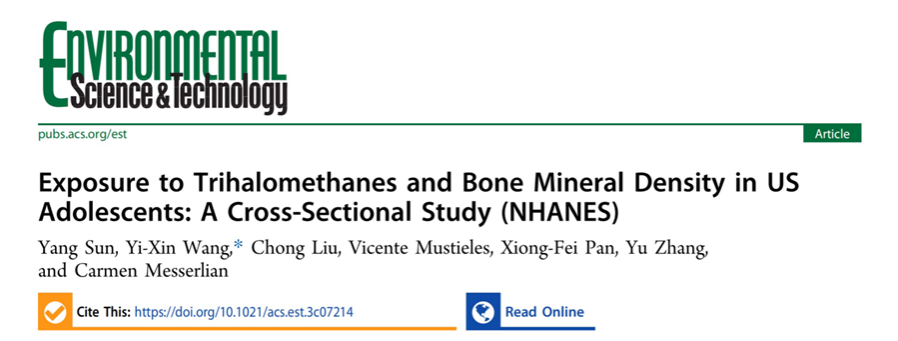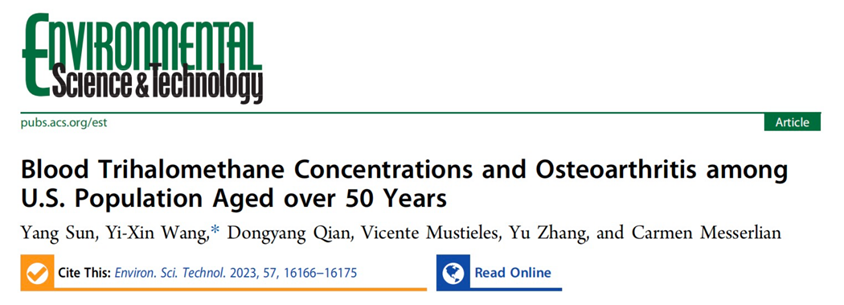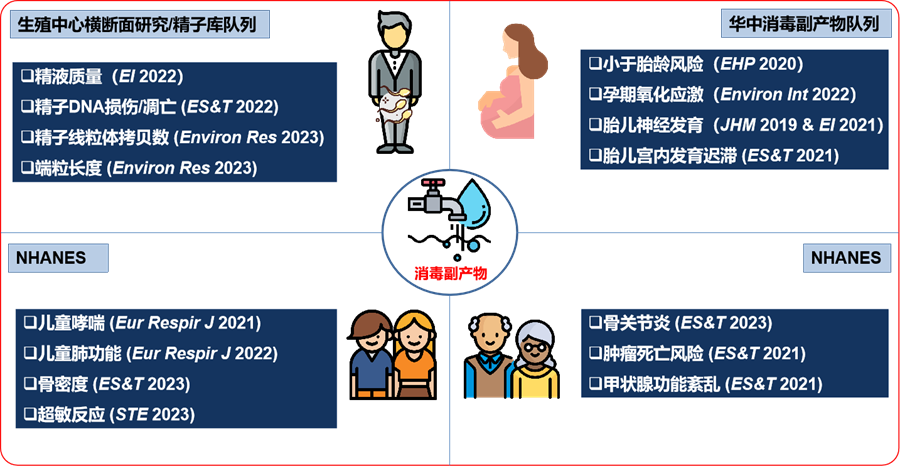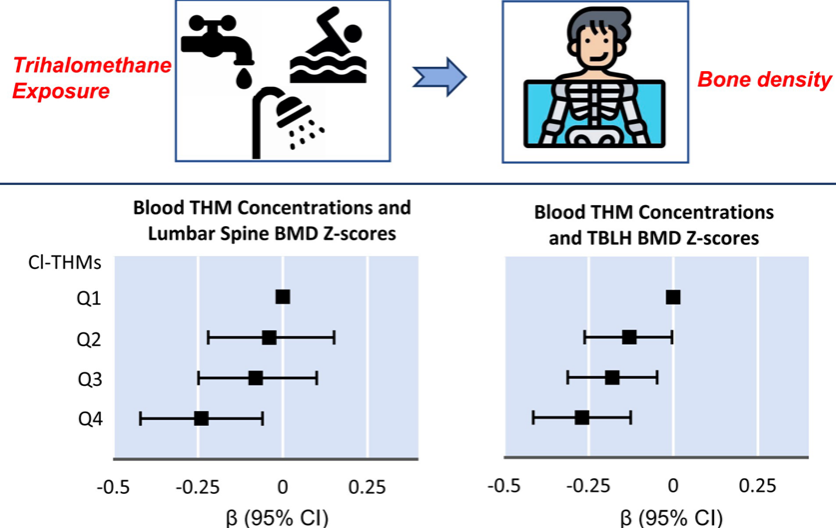Recently, Prof. Yi-Xin Wang from the School of Public Health at Shanghai Jiao Tong University, in collaboration with an international team, analyzed data from the National Health and Nutrition Examination Survey (NHANES) to study the effects of exposure to disinfection by-products on bone density in children and adolescents, as well as the occurrence of bone and joint diseases in middle-aged and elderly individuals. The study found that exposure to trihalomethanes (THMs) in drinking water may not only lead to reduced bone density in children and adolescents but also increase the risk of bone and joint diseases in middle-aged and elderly individuals. This research reveals, for the first time, that exposure to disinfection by-products during routine water activities may compromise bone health in humans, holding significant scientific implications for the prevention of bone-related diseases. The research findings have been published successively in the high-impact journal Environmental Science & Technology (IF=11.4).


Disinfection by-products (DBPs) are a series of compounds formed during the disinfection process of drinking water when disinfectants (such as chlorine and chloramine) react with natural organic or inorganic substances in water. There are over a hundred types of DBPs, with trihalomethanes (THMs) and haloacetic acids (HAAs) being the most abundant, accounting for 66% and 27% of all disinfection by-products, respectively. Individuals may be exposed to disinfection by-products through activities such as drinking water, bathing, and swimming. Toxicological studies have found that THMs and HAAs have carcinogenic, teratogenic, and mutagenic effects, leading to their classification as Group 2B carcinogens by the World Health Organization. The research team led by YiXin Wang, known as the Reproductive and Environmental Nexus for Extended Wellness (RENEW Lab), focuses on studying the reproductive and long-term health effects of disinfection by-products. They have established cross-sectional studies and sperm bank cohorts at the Central Reproductive Center, using blood THM concentrations and urine HAA concentrations as biomarkers of individual exposure. The research revealed that exposure to disinfection by-products may lead to decreased semen quality parameters in males, sperm DNA damage, cell apoptosis, decreased sperm mitochondrial copy numbers, and shortened telomere length. To further investigate the impact of disinfection by-products on pregnancy outcomes, the team established a cohort of disinfection by-product exposure in the Central China region, reporting for the first time internationally that exposure to different disinfection by-products during pregnancy may lead to increased oxidative stress levels during pregnancy, increased risk of preterm birth, impaired fetal neurodevelopment, and intrauterine growth retardation. To further explore the long-term health effects of disinfection by-product exposure, RENEW Lab utilized the NHANES database in the United States to report for the first time internationally that exposure to THMs may lead to increased risk of hypersensitivity reactions, asthma, and decreased lung function in adolescents, as well as thyroid dysfunction and increased risk of tumor mortality in adults. The research findings have been successively published in high-impact journals in environmental or medical fields, such as Eur Respir J (2 papers, IF=24.3), EHP (IF=10.3), ES&T (6 papers, IF=11.4), Environ Int (3 papers, IF=11.8), and J Hazard Mater (IF=13.6).

Previous toxicological studies have suggested that disinfection by-products may also impair bone health, but research on relevant populations is extremely scarce. To explore the effects of disinfection by-products on bone density in children and adolescents, the RENEW Lab, in collaboration with an international team, included 2497 adolescents aged 12-19 years and used multivariate linear regression models to analyze the association between blood THM concentrations and household tap water THM concentrations and lumbar spine and whole-body bone density. The study found that for every 2.7-fold increase in individual blood concentrations of trichloroacetic acid, dichlorobromomethane, chlorodibromomethane, and total THMs, lumbar spine bone density z-scores decreased by -0.06 (95% CI: -0.12, -0.01), -0.16 (95% CI: -0.11, -0.003), -0.08 (95% CI: -0.14, -0.02), and -0.07 (95% CI: -0.13, -0.003), respectively. For every 2.7-fold increase in individual blood concentrations of dichlorobromomethane, chlorodibromomethane, and chloroform, whole-body bone density z-scores decreased by -0.10 (95% CI: -0.17, -0.02), -0.10 (95% CI: -0.17, -0.03), and -0.11 (95% CI: -0.20, -0.01), respectively. The prediction accuracy of household tap water THM concentrations for individual blood THM concentrations was poor, with only a dose-response relationship found between increased tap water concentrations of chlorodibromomethane and decreased whole-body bone density z-scores.

To explore the effects of disinfection by-products on bone and joint diseases in middle-aged and elderly individuals, the RENEW Lab, in collaboration with an international team, included 4077 individuals aged 50 years and older and used multivariate logistic regression analysis to analyze the association between individual blood THM concentrations and the risk of osteoarthritis, inflammation, and oxidative stress markers. The study found that increasing blood concentrations of dichlorobromomethane, chlorodibromomethane, and bromodichloromethane were associated with increased risk of osteoarthritis, with odds ratios of 1.46 (1.09-1.94), 1.53 (1.15-2.04), and 1.35 (0.97-1.88), respectively. Furthermore, increasing blood concentrations of dichlorobromomethane, chlorodibromomethane, and bromodichloromethane were associated with increased levels of the oxidative stress marker γ-glutamyltransferase.

Prof. Yi-Xin Wang from the School of Public Health at Shanghai Jiao Tong University, Department of Environmental Health, is the corresponding author of two papers. Other authors include Prof. Yang Sun from the Sixth People's Hospital of Shanghai Jiao Tong University School of Medicine, Professor Carmen Messerlian and Dr. Yu Zhang from the Harvard T.H. Chan School of Public Health, and Dr. Vicente Mustieles from the University of Granada, Spain, among others. The RENEW Lab focuses on environmental/reproductive epidemiology and has published over a hundred first/corresponding author papers in journals such as BMJ (3), JAMA Intern Med, Eur Respir J (2), Eur Heart J, JACC, EHP (3), etc. The research group regularly accepts applications for master's/Ph.D. and postdoctoral positions. For inquiries, please contact via email: yixin_wang@shsmu.edu.cn
Article link:
Sun Y, Wang YX, Qian D, Mustieles V, Zhang Y, Messerlian C. Blood Trihalomethane Concentrations and Osteoarthritis among U.S. Population Aged over 50 Years. Environ Sci Technol. 2023 Oct 31;57(43):16166-16175. doi: 10.1021/acs.est.3c01495. Epub 2023 Oct 18. PMID: 37852642.
Sun Y, Wang YX, Liu C, Mustieles V, Pan XF, Zhang Y, Messerlian C. Exposure to Trihalomethanes and Bone Mineral Density in US Adolescents: A Cross-Sectional Study (NHANES). Environ Sci Technol. 2023. doi: 10.1021/acs.est.3c07214.




